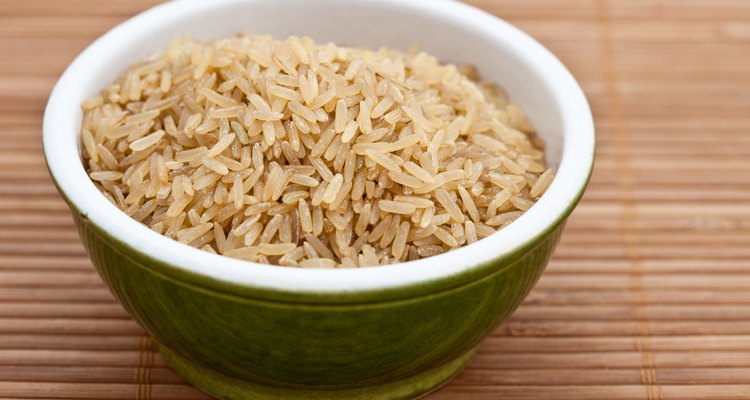
Robert Anthony/iStock/Getty Images
Rice serves as one of the main sources of dietary energy, providing 20 percent of the world's dietary energy supply, according to the Food and Agricultural Organization of the United Nations. Rice contains proteins, vitamins and minerals and offers the flexibility to prepare it as a main dish, side dish, dessert or candy.
Carbohydrate Content
Rice is a starchy food mainly consisting of carbohydrates, a type of macronutrient made up of sugar molecules linked together. The National Institutes of Medicine Food and Nutrition Board recommend that carbohydrates make up 45 to 65 percent of your daily calories. Because the body can quickly break down carbohydrates into glucose -- the body’s main source of energy -- they serve as the best source of dietary energy. Brown rice contains 75 to 85 percent carbohydrates while white rice contains 90 percent carbohydrates, according to Michael Frei and Klaus Becker of the Institute of Animal Production in the Tropics and Subtropics.
Rice Protein
Rice also contains protein. Proteins consist of amino acids, commonly known as the building blocks of protein. Although the human body can produce some necessary amino acids, others, known as the essential amino acids, must be ingested in foods. Animal-based foods serve as a source of complete protein, meaning it provides all of the essential amino acids. Rice has proteins known as incomplete proteins because it fails to provide all of the essential amino acids. Rice protein, although classified as incomplete, is considered a high quality protein. The amount of protein in rice ranges from 7 percent to 16 percent depending on the variety of rice, according to the research from the Institute of Animal Production in the Tropics and Subtropics. In some countries rice remains one of the main sources of protein.
Vitamins
Rice also contributes vitamins to your diet. Because the outer layer known as the rice bran contains the majority of the vitamins and minerals, brown rice provides the most nutrition. Rice bran contains vitamin E which supports a healthy immune system, aids in chemical reactions and acts as an antioxidant by protecting the cells from damage. Brown rice also contains several of the B vitamins including thiamin, riboflavin and niacin, all of which promote the efficient breakdown of foods and use of energy.
Minerals
Just as with the vitamins and proteins, most of the minerals can be found on the outer bran layer of the rice. Rice provides iron, a mineral necessary for the production of proteins and enzymes, which helps to prevent iron-deficiency anemia, a condition that causes severe fatigue. Rice also contains zinc to support normal growth and development, phosphorus used to build strong bones and teeth, potassium necessary for normal organ function and magnesium to help support hundreds of chemical reactions in the body.
Related Articles

Nutritional Value of Cooked Black Rice

How to Make Sweet Brown Rice
How to Cook Volcano Rice

Nutrition From Beans & Rice

Does Rice Taste Different Depending on ...

Vitamin B2 for Hair Growth

How to Dry Out Sticky Rice

How to Cook Japanese Rice

Is Jasmine Rice Naturally White or Is ...

How Long After a Sell-By Date Can You ...
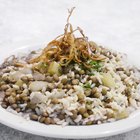
Do Lentils & Rice Have Calcium & ...
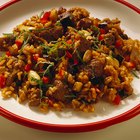
Brown Basmati Rice Cooking Directions
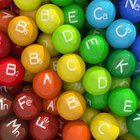
What Vitamins Help the Liver?
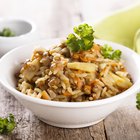
Rice and Lentils for Nutrition

Flaxseed Meal Nutrition

How to Cook Long Grain Rice

Ingredients in Hairfinity Vitamins

Vitamins for Mental Alertness

How to Cook Rice in Foil

Elastin Supplements
References
- Institute of Animal Production in the Tropics and Subtropics: Rice, Biodiversity and Nutrients
- Food and Agriculture Organization of the United Nations: Rice and Human Nutrition
- National Institutes of Health Office of Dietary Supplements: Vitamin E
- National Institutes of Health Office of Dietary Supplements: Iron
- University of Maryland Medical Center: Phosphorus
Writer Bio
Stephanie Chandler is a freelance writer whose master's degree in biomedical science and over 15 years experience in the scientific and pharmaceutical professions provide her with the knowledge to contribute to health topics. Chandler has been writing for corporations and small businesses since 1991. In addition to writing scientific papers and procedures, her articles are published on Overstock.com and other websites.
Photo Credits
Robert Anthony/iStock/Getty Images